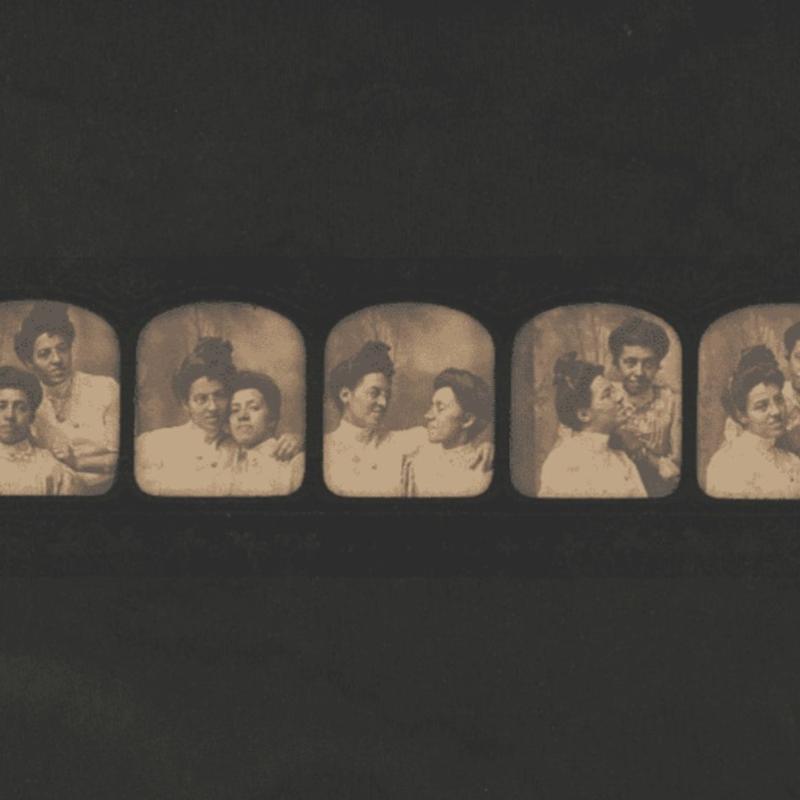Not Just Forgotten, but Erased From History: A Final Note from Notes from America

Kai Wright: I'm Kai Wright, and I met a listener recently, one of you, who showed up at a live event we held and asked a great question. They asked me, "As a professional storyteller, what do I do with the knowledge that some stories are lost to history? Because they've been blotted out of the record, are just overlooked by those of us in the media who write history's rough draft? Once that form of erasure happens, it's really tough to reverse. It's also consequential because very often those are the stories that present the greatest challenges to the status quo."
I didn't have an immediate answer for that listener, but the question reminded me of one of my absolute favorite conversations on this show. Coming up on Notes From America, we revisit the lyrical work of cultural historian Saidiya Hartman and her book Wayward Lives, Beautiful Experiments. We'll hear the stories she has reclaimed from history's dustbin just ahead on Notes From America right after this.
History isn't cut and dry. There was not some tome of facts that was has been handed down in generations to generations, and we all read off the same book. If history is cut and dry, someone's got to cut it. Someone's got to dry it, right?
Female 1: Black studies are really efforts to capture the ways that the history experiences, culture, lives of Black people, African Americans, what our lives are about, what constitutes them historically, culturally, politically, over time.
Male 1: You can kind of walk through the history of black America in this way that Black people were emancipated because it was in the interests of the country to preserve the union.
[music]
Kai: It's Notes From America. I'm Kai Wright, and welcome to our final show. At the end of this episode, we'll sign off for good. I've been working on this project in one fashion or another for about eight years, and it has truly consumed a large swath of my mind and heart throughout that entire time. As I thought about how we would wrap up in this final episode, like what concluding thought we'd offer, I honestly was kind of at a loss. There's just too much to consider.
Then I noticed I'd been thinking a lot about an episode we made almost four years ago. When I went back and relistened to that conversation, I realized it offers not a conclusion that seems undoable, but rather an illustration of where my mind's at right now in this moment of intense backlash with the return to power of a political movement dedicated to stamping out ideas that are important to me.
Ideas about equity, about sharing resources, and working together rather than hoarding opportunities. Ideas about celebrating our differences rather than fearing them. Anyway, one thing I'm thinking about in this chilling moment is that reactionary movements, those that aim to reverse progress, they have to also erase the people whose lives drive that progress. That's why they get so personally nasty, why they stoke such vitriol and argue so angrily about history itself.
It's also why there are so many buried stories in our history because they're the stories of people whose very existence challenged the narrative. Someone in power wanted to impose those people, and their stories are on my mind. Back in 2021, I talked with somebody who was poking around in our history, listening for those faint voices of true progress, and then bringing them back to life in the most beautiful and lyrical way.
Saidiya Hartman: I'm Saidiya Hartman, and I'm a writer and a cultural historian.
Kai: Saidiya has been a MacArthur genius fellow and is a professor of English and comparative literature at Columbia University. Her most recent book has one of the most fantastic titles in print. It's called Wayward Lives, Beautiful Experiments: Intimate Histories of Riotous Black Girls, Troublesome Women, and Queer Radicals. She and I spoke last week and we're going to spend the whole show in the conversation I had with her. Her work is so fascinating and unconventional that when we met, I had to start by just trying to understand how she even thinks about it as an academic discipline. I've seen some debate about where your work fits in the world. How do you think of your work?
Saidiya: That's a really complex question because I think that I'm really involved in something that's more like historical poetics. Historians like to say, the ones who actually respect the work, "Oh, yes, we respect that work. She really shouldn't do the thing she does, but she gets away with it. Graduate students don't do what she does." I'm an outlier who is fortunate enough to be engaged by historians, but you're right, I don't actually fit into the category.
Kai: For yourself, you don't think you fit in that category. That's not what you're aspiring to. You're aspiring to something different.
Saidiya: I think that's changed over time. I think that in wayward lives, beautiful experiments, something shifted and I crossed a boundary. I don't think there's any going back. I joke that my method is as wayward as those I write about. I think that "cultural historian" maybe now fits less well than it did in the past.
[music]
Kai: Settle in, make yourself some tea or something. We're not taking calls. We're just going to let Saidiya tell us a few stories of the wayward lives and beautiful experiments that she's discovered. She's focused on the turn of the 20th century in this book, and she's digging around in the archives, finding snippets and flashes of life, and then trying to either more fully document those lives or sometimes just imagine their worlds. For us, I asked her to begin by reading a section from one of her early chapters in which she describes this time and the people in it who have captured her mind.
[music]
Saidiya: It was an age when Negroes were the most beautiful people, and this was no less true of her. Even her detractors reluctantly admitted as much. It is hard to explain what's beautiful about a rather ordinary colored girl of no exceptional talents, a face difficult to discern in the crowd, an average chorion not destined to be a star, or even the heroine of the feminist plot.
In some regard, it is to recognize the obvious, but that which is reluctantly seated. The beauty of the block, ordinary, the beauty that resides in and animates the determination to live free. The beauty that propels the experiments in living otherwise. It encompasses the extraordinary and the mundane art and everyday use. Beauty is not a luxury, rather it is a way of creating possibility in the space of enclosure, a radical art of subsistence and embrace of our terribleness, a transfiguration of the given. It is a will to adorn, a proclivity for the baroque, and the love of too much.
Kai: The love of "too much." Correct me if I'm wrong, but it's almost, you're describing a composite of the human that you are searching for in the archives in this book. Is that the case, and if so, what is the origin of that? Why are you seeking out that person?
Saidiya: I think that you're right. As I began to do the research for this book, I had this encounter with a photograph by Thomas Eakins. In the photograph, it was a nude photograph of a young, Black girl, maybe 9, 10, 11 years old. I thought, "Who is she? How did she wind up in the studio? Under what conditions did she find herself naked and being photographed by Eakins and his team?"
That figure initiated the quest. In some sense, the book is about the impossible search for this figure, and it traces her through the lives of a number of young women and young genderqueer folk. It is a serial portrait. All of those who I write about are this young girl and none of them are.
Kai: You said, "an impossible search," because the point is that these are people who appear in the archives, but only in flashes.
Saidiya: Yes, and often that is how Black girls and women appear in historical archives, whether in the archive of slavery, stripped of names, and any identity. Here she's denied even a first name. That seems really exemplary of the problem of history and its proper subjects. We think about these representative figures, these exceptional figures, these notable figures. How does one write an account of a nameless figure?
Rather than that being a deterrent to finding out about her life for me, it's the incitement. I'm like, "What was her journey through the streets of the city? Where might she have lived? Who were all the other girls who were like her, who crossed paths with her?" I think that a central question is who's fit to be a historical subject? Who's imagined as being capable of transforming history, transforming social relations? Certainly not poor Black girls.
Kai: That passage begins, "It was an age when Negroes were the most beautiful people." What is this age? Why do you describe it that way?
Saidiya: If we think of just early 20th century, American literature, if we think by the time that there's the advent of the jazz age, there's something about Black maternity or young Black men and women in the city cutting too fine a figure, too much in love with beauty, which is considered dangerous and wasteful and transgressive, but yet no one can deny it. Even the white reformers who would eradicate the behavior acknowledged, "My God, they look really good."
There's a suspicion that's connected with the inexpensive, but beautiful clothes, the too many ribbons, the flash, and the style, or the leader and intellectual Alexander Crummell, who actually delivered sermons about the dangers of aesthetical Negroes. I love that. The fact that it sounds like the name of a band.
Kai: Aesthetical Negroes.
Saidiya: Aesthetical Negroes. [laughter] Again, that aesthetical, it's not aesthetic it's aesthetical and the aesthetical is precisely about the "too much."
Kai: May we all be aesthetical Negroes.
Saidiya: Exactly, exactly. Zora Neale Hurston, in her essay, the Characteristics of Negro Expression, she provides a formal language for this "too much". She talks about all of these things that are considered excessive, baroque, but those are so wonderful. As I watch these aesthetical Negroes move through the city and create lives, I just thought, "Yes," and I just wanted to be in that moment of possibility with them.
Kai: You're listening to a conversation I had in 2021 with cultural historian Saidiya Hartman. Coming up, we join Saidiya in a Moment of Possibility, the story of May Enoch and Arthur Harris, just ahead. I'm Kai Wright, and this is a final episode of Notes From America. Stay with us.
[advertisement]
Kai: It's Notes From America, I'm Kai Wright. This week we are revisiting a conversation I had in 2021 with cultural historian Saidiya Hartman. Saidiya describes her work as historical poetics, which sounds right to me. In her book Wayward Lives, Beautiful Experiments, she rummages around in the archives of the early 20th century, looking for accounts of the kind of everyday radical lives that rarely make it into history books Tell me the story of May Enoch and Arthur Harris.
Saidiya: May Enoch and Arthur Harris were the young working-class Black people who were entering the city. They entered New York City in 1900. There was a way in which they weren't welcomed by, old Negroes of New York because, in all of these cities, this is also true of Philadelphia, there's a small presence of Black folks, and many of those people are respectable Black folks. They're not identified as a problem in the city. We're beginning to see these waves of new migrants. There's a fear of their presence by the white establishment. The Negro establishment is only slightly less unwelcoming.
You have just May and Arthur out in the world in the summer. Arthur is in the bar having drinks with his friend, May is waiting for him outside, and she's calling, "Arthur, come on, I'm waiting out here too long." While she's waiting for him, a police officer who's not wearing a uniform simply grabs her and pulls her up the street, of course mistaking her for a prostitute, which is how the racialized gaze saw Black women who were occupying public space. They were prostitutes. In the case of Arthur, he responds and he gets in a brawl with this white man who they later find out is a police officer.
Kai: This is 1900 there in the Tenderloin in New York. Can you just say a few words about the scene in the Tenderloin?
Saidiya: The Tenderloin was the vice district of the city. It extended between 20th and 53rd streets, west of Sixth Avenue, and running along the waterfront. What was interesting in terms of the racial organization of the Tenderloin is that the avenues were ethnic. They were Italian and Irish and Jewish, and then the side streets were Black. It was called Tenderloin because the corruption was so great that the police officers received the biggest payments there. They would say that the tenderest and juiciest part of the graph to be taken was from the Tenderloin.
The scene that they would be a part of would be just the densely packed life. It was hot so everyone was in the street. It was two o'clock in the morning. The streets were packed. The tenement is hot. People are sleeping on fire escapes. People are sleeping on the front steps. People are sleeping in the foyers. It's that public aliveness and that proximity of city life and there's an excitement about that. If Black folks can make a way for themselves anywhere, certainly it's got to be New York. It's that nascent sense of possibility that they embody.
Kai: When this altercation happens, Arthur kills the white man in the end. He stabs him and the man dies in the street, and it turns out that he's a cop. Just describe what happens from there.
Saidiya: Basically there is a search for Arthur Harris, but at the funeral, two days later for Thorpe, the police officer, a woman at the wake, sees a young Black man walking down the street and says, "Oh, there's a Black person. Let's kill him." She didn't use the term "Black person". Then that incites this mob action that engulfs the city, and basically every Negro is targeted.
Women are pulled off streetcars and beaten, children are beaten, white neighbors turn on their black neighbors. Violence engulfs the city for all of those days, and the riot also becomes a factor, then in the migration of Black folks, out of the Tenderloin and uptown to Harlem.
Kai: Coming back to May and Arthur, and that fateful night, the part of their story where they're in the bar and they're leaving the bar, when the officer grabs them, it seems like it doesn't occur to them that this is about to be a problem. They're just in a moment of such joy.
Saidiya: It doesn't occur to them. I think it's also just the assumption of the equality of Northern space. Arthur is like, "What are you doing with your hands on my partner?" He's ready to defend her and to confront a white man in the street. I think that that sense of defiance is also something that characterizes the new Negro. It's something that the white mob reacted to. Literally, the description is "Who are these Negroes moving through the streets with so much swagger and attitude? They don't know their place." That's what the city represents, the possibility of no longer having to be confined to a place.
Kai: What really struck me in reading this particular story in the book is how it ends because, in that era, Black thinkers and organizers, we are trying to record our own facts about this violence. There's community journalism that's going on, there's public history that's going on, so the community does in fact chronicle this story. When the story is written, when we write, when Black people write this story, May Enoch is entirely absent from it. It choked me up to say it.
Saidiya: There's a strategy for achieving Negro rights and equality and that's about the politics of respectability. Black people, if we can consistently present our best face, if we demonstrate that we share the same values, that we ascribe to the same moral norms, well then maybe eventually white folks will recognize that and we will be granted an equal footing.
The likes of May and Arthur were outside that framework of respectability. They were in a marriage that "wasn't illegal marriage". It was a common-law marriage. The police immediately described May as a prostitute, Arthur didn't denounce his violence. He only says in the context of the court trial, "Oh, had I known he was an officer, it would have been different."
We produced this record, but even that record has certain kinds of exclusions. We have Black intellectuals, like Paul Laurence Dunbar, and others who are saying that "These people shouldn't be migrating to the city. There are a problem." That there's a new level of conflict that's happening because this type of Black folk is entering the city and too great a number.
[music]
Kai: Perhaps the most famous black intellectual of the early 20th century was among those who were truly uncomfortable with the life choices of poor black people in northern cities. W.E.B. Du Bois was a young man at the time. He was a rising star in academia, and his perspective on Black life was increasingly definitive. At the time, he was studying black Philadelphia specifically, and he did not like what he saw. This is the part of his story that doesn't often get told. Who is Du Bois at this moment?
Saidiya: Du Bois is a brilliant 28-year-old, who's arrived in the Seventh Ward with his new wife. Basically, he's been hired to do a study of the Black community. As he writes, he says, "There was the notion that there was a problem and Negroes were the problem. They invited me to come down and document why this was the case." Du Bois is just this brilliant bundle of contradictions. I think we need to think of him in this period as an elitist, as a Victorian, much of what he sees horrifies him. It is hard for him to look at young girls in the street and not imagine that they're prostitutes.
He is in a phase of his career where he's still very much an idealist. He thinks that "If I only describe the problem of racism well enough," that that's going to be enough to change it. He thinks that science and sociology in particular is going to provide the tools to illuminate the problems of racism and to defeat racism. A decade later, he's in a radically different position.
Kai: I'm particularly curious about the immorality piece of it, that everything about the people's lives that he's witnessing, that may be associated with poverty, maybe just associated with a different kind of life than he would live is seen as immoral, both by him and by white reformers of the times. Why is the immorality piece? Where does the moralism come from?
Saidiya: The moralism comes from this notion that was widely shared among Black thinkers, reformers, and progressive intellectuals, that slavery had been utterly damaging, and that we were, in essence, like children in the school of moral development because families had been broken under slavery. There was a sense that we had to be trained to live in accordance with those bourgeois hetero-normative values.
Du Bois says something in The Philadelphia Negro that for me is so important. He says, "The Negro church is an older institution than the Black family." That's the heart of the anxiety that we have a sociality, that has a different kind of mapping. At this moment, I think that the expression of sexual desire outside of marriage is unfathomable to Du Bois because of his concerns about a certain kind of racial progress.
I also say because that's also so ingrained in the Black middle class, here he is a newlywed with his wife. They have a very unsatisfying and difficult sexual life precisely because a decent girl isn't raised to believe that that's something that she should want. Even as Nina will yield to sexuality, it's not that she has a longing or a hunger or desire. We see him really living those extremes.
Kai: Then when he steps into this world of-- where people are openly engaged in pleasure men and women alike, that is shocking to him?
Saidiya: It's shocking. There's also this reality, a part of the absence of Black male heads of household. It was simply due to the very high death rate among Black men. There were so many Black widows. Then those widows would form secondary relationships often outside the context of legal marriage or people would describe themselves as married but not having legal status. For Du Bois, it was a matter of concern and a matter to be corrected and adjusted.
Kai: One of the things you described that he can't quite take in is the way in which public and private space and intimacy in public and private space operates differently than it does in middle-class society. You write with such joy, it seems like, he really quite liked the way that that space is mixed up. Can you describe that a little bit?
Saidiya: For me, that's part of the birth of the modern. It's that encounter and proximity of strangers. It's the crossing of all of these boundaries. I remember, there's one reformer who says, "Had I known people were sleeping in the foyer or on rooftops, I would have forbade it but it never occurred to me, that people who would do that." A decade or so later, it becomes fashionable among the rich to sleep on their rooftops, but basically, it's a way to escape the heat and the confinement of the tenement.
Kai: Just to interrupt, I like this part of Saidiya's writing so much. I actually asked her to read a passage from her book, in which she describes the kind of scene Du Bois would have regularly encountered in Philadelphia Seventh Ward. This is right at the corner of 7th and Lombard.
Saidiya: Slick, fresh mouth boys, comely, buxom girls, policy runners, ne'er-do-wells, petty gangsters, domestics, longshoreman, and whores. The young and the striving, the old and the dissipated, gathered on the corner of 7th and Lombard. The air was thick with laughter, boasts of conquest, lies bigger than the men who told them. Idlers loud-talk one another in an orchestrated battle of words. Pimps croon, "Hey girl, send it on," to each and every woman under 30 who strolled by. Bulldaggers undress the pretty ones with a glance.
Passers-by could overhear a wishful full story shared about the good things yet to come. Hard-working folks and jaded pleasure seekers joked and despair. This is the future we was waiting for? The beautiful anarchy of the corner refuse no one. It was the one place where they could quit searching and rest for a while and still believe they were moving and on the way to someplace better than this. Free association was the only rule and promiscuous social life. It's defining character.
All were permitted to stay briefly, catch their breath, resist the pull of roaming, hustling, and searching. Every hour, someone remarked, "I got to go," and then lingered. Newcomers refresh the crowd. Strangers became intimates. The flow of those arriving and departing kept it alive. The same folks were always there and yet it always looked different. It's just this hustle-bustle. It's a sensory overload. That sensory overload can be described by reformers as wretched and that sensory overload is also dazzling.
[music]
Kai: I'm talking with author and cultural historian Saidiya Hartman. We spoke during Black History Month in 2021 about the entirely new questions we ask if we visit history from the perspective of its dazzling street corners rather than that of its so-called great men. Coming up, the cultural revolution that erupted in black neighborhoods at the turn of the 20th century and the new rules that elites created in response. That's next.
[music]
It's Notes From America. I'm Kai Wright, and we are revisiting a conversation I had in 2021 with writer and cultural historian Saidiya Hartman. Before the break, she explained why black intellectuals and white progressives at the turn of the 20th century were so disturbed by the way poor black people in northern cities lived and socialized. Their middle-class assumptions blinded them to the cultural revolution that was erupting amid the chaos and the crowding of those urban neighborhoods.
Saidiya: Another way I like to think about it is as an aesthetic resource when I talk about the air shaft. What those air shafts in buildings mean is that you're in the fifth floor but you can hear your neighbors on the third floor arguing or making love or going through their drama. You know what the person on the second floor is cooking for dinner.
Both Duke Ellington and Ethel Waters, they talk explicitly about the air shaft as a side of their creative inspiration. Ethel Waters said, "I would hear an argument and then I would write the lyrics to a song."
[music]
Duke Ellington talks about building compositions on that beautiful cacophony of tenement life. [music] That is for me, the experiment and living otherwise. It's not simply that working class and poor folks fail to meet some bourgeois standard, but there's another set of standards and values that are work.
Reformers were so intent on creating a visual order that they actually misrepresented urban space. We see this in the photographs of the Seventh Ward in Philadelphia. Even when you have communities, you have Black folks who are living next door to Russian Jews, who are living down the street from the Italians. The caption of the photo will say, "Negro Quarter." Even as you see the Russian Jewish boys, two houses away sitting on their steps, when they take a picture of that community, they gather all the Negro children and take a photo of them and then they gather all the Jewish children and take a photo of them.
When I was looking through the archive, there's one photo where there's a Negro girl, who's standing on the edge of the frame of the photo of the Jewish children. I was like, "Oh, my God, this is literally the same neighborhood, but they've chosen to order space in that way."
Kai: Trying to impose this new order on what was happening organically there. That is so-
Saidiya: There's nothing that's natural about segregation as a way of living. It's an imposition. It's created through law in the Southern context, but in places like Philadelphia and New York, it was largely created through philanthropists, reformers, and committees of the rich who thought interracial sociality was the danger so they utilized all of these extra-legal means to prevent it.
[music]
Kai: To understand the extralegal means that Saidiya is talking about, we need a short detour. In her book Wayward Lives, Beautiful Experiments, she uses a metaphor of a chorus to evoke the voices and perspectives of the people who the elite reformers found just really disturbing and who would be targeted with these extralegal means of enforcing middle-class values. I asked Saidiya to read a section of her book in which she kind of muses on the life of the chorus and to first explain why this metaphor is such a big deal for her.
Saidiya: The chorus speaks to the multitude that really shapes the course of our history and while we often focus on the charismatic male leader or the speaker at the podium that's what the movement is. That multitude provides the audience for the speaker, animates those ideas, takes it up. For me, the sense of how the multitude moves was embodied by the figure of the chorus.
Dancing and singing fuel the radical hope of living otherwise. In this way, choreography was just another kind of movement for freedom, another opportunity to escape service, another elaboration of the general strike. Joining the chorus encompass much more than the sequence of steps or the arrangement of dances on the stage of a music hall or the floor of a cabaret.
Like the flight from the plantation, the escape from slavery, the migration from the South, the rush into the city or the stroll down Lenox Avenue choreography was an art, a practice of moving even when there was nowhere else to go, no place left to run. It was an arrangement of the body to elude capture, an effort to make the uninhabitable livable, to escape the confinement of a four-cornered world, a tight airless room, tumult, upheaval flight. It was the articulation of living free or at the very least trying to. It was the way to insist, "I am unavailable for servitude. I refuse it."
Kai: Saidiya is interested in the ways in which this refusal led young Black women who were living inside these new racial ghettos to start making radically different life choices than those of mainstream society. She's also interested in the ways that liberal reformers, white and Black alike came up with new ways to police those life choices. One of which is still with us today, the idea of a status crime.
Saidiya: A status crime is something that is-- it is only a crime when certain people do it. It's not against the law to have sex, but if you're underage, then being sexually active can become a status crime. It's a crime depending on what your status is. If you are a poor person in Harlem drinking a bottle of wine on the corner, you can be arrested by the police. If you're sitting outside on the patio of a restaurant, drinking bottles of champagne, you won't be arrested.
That's a way in which we think about like, "Oh, it's the same behavior, drinking wine, but one is a violation because of the conditions and the status of the person who's doing it." There were a range of these status offenses which directed young women into the reformatory. Because they weren't accused of real crimes, the magistrate judges had lots of flexibility in sentencing. They were without the norms of due process because technically they hadn't committed crimes. They were status offenses.
The idea was, "Oh, if we can actually reform them at this early age, they will avoid the later pitfalls of criminality that await them seemingly just because they're sexual and desiring subjects in the world."
Kai: To illustrate the point, Saidiya tells me the story of Harriet Powell.
Saidiya: Harriet Powell is a very smart, unrepentant, too-loud, Black girl.
Kai: She falls in with a young man, Charlie Hudson, and they fall for each other. Can you just describe their couple of days together, a little bit?
Saidiya: Basically, they meet at a dance hall, they have a sexual encounter, and then they decided, "Oh, let's hook up again." At this point, Harriet's family is upset that she's out at the dance hall and carrying on, so they say, "Oh, our daughter is missing." She's on the dance floor and a police officer comes over to her as she's dancing and she's arrested for being incorrigible. Here she is, it's working. She's out. She stayed out overnight with her lover and she's on the dance floor and she's arrested.
Kai: A young woman like Harriet, who was arrested in this way would be sent to the women's court. What was the women's court? What was that?
Saidiya: The woman's court was a court that was specifically created to "protect women", and to prevent the leering and voyeurism of women being charged with prostitution and all these crimes in an open court. It was founded as a reform of the criminal justice system. These are progressive reformers trying to-- they thought that they were creating something like a boutique sentencing structure.
There was indeterminate sentencing because ideally, the reformatory would be able to gauge when a young girl was ready to return to her life in the world. What that meant in practice was that everyone received a maximum sentence of three years. Ultimately, these young women are criminalized for their sexuality. They're criminalized for having intimate lives outside of marriage and that's what the struggle is about. It's really a struggle about values.
I think that when we think of the revolution before Gatsby, so when an educated elite enacts the same forms of practice, then it is a sexual revolution than it is a revolution in values. When young working-class Black and immigrant women are doing the same thing, it's a matter of moral failure and criminality. Who can be a radical agent of change? It's easy to imagine that educated elites could do that. Are people able to imagine that poor Black girls were as devoted to forging another path for themselves?
Kai: You write about the story of Billie Holiday, who got arrested for one of these crimes as a young woman and responded to it with a savvy tape.
[MUSIC - Billie Holiday: Fine and Mellow]
Can you tell that story?
Saidiya: Yes. Billie Holiday is arrested because the police are targeting Harlem and Black neighborhoods. They have these things called jump warrants, which I like to point out are exactly like the no-knock warrant that resulted in Breonna Taylor's death so that they could actually just enter a house without any kind of warrant. She's arrested. She lies about her age because she says, "Oh, if they think I'm an adult, it's only 60 days or 90 days on Blackwell's Island, as opposed to two or three years at the reformatory."
Kai: Let me just interrupt the conversation here because there's a beat in the story, this idea tells me here, that made me love Lady Day even more than I already do. The magistrate who sentenced her was famous because she was the first woman to have that job in New York City and Billie Holiday thought that was a missed opportunity for herself.
Saidiya: She says, "Too bad, she wasn't a lesbian because if she had then I probably would have gotten no sentence at all." Holiday is so convinced of her feminine charms and her ability to seduce, but Holiday knows exactly how the system works. Even when she's imprisoned on Blackwell's Island, she wins the affection of a lesbian guard who gives her all these kinds of favors.
Those who are experienced do that, but for Harriet Powell, then it is the beginning of a decade-long entanglement with the police in these correctional facilities because then if you come out, you're on probation and you have a violation, then you can be sent back. In that regard, it's very much like the "school to prison" pipeline that we are seeing today.
Kai: There's all these ways in which some of these laws in particular echo in today. I also wonder about the ways in which these ideas echo into today. As I read, I kept hearing the phrase at risk that we throw around today. I wonder how you feel about the way these ideas have carried into the way we think about blackness.
Saidiya: Unfortunately I think that they have totally carried into the way we think about blackness today and they continue to shape social policy. We see it under Republicans with these marriage initiatives for the poor or those who are on welfare. We see it in terms of the totally demonizing discourse around teenage mothers and this seemingly interminable discourse about the crisis of the Black family in spite of evidence to the contrary.
Kai: Saidiya Hartman is author of Wayward Lives, Beautiful Experiments: Intimate Histories of Riotous Black Girls, Troublesome Women, and Queer Radicals. We initially aired this conversation in 2021. I said at the outset this week that I'm sharing it now as our final episode not as a conclusion, but more as an illustration of what I'm thinking about. I'm thinking about the personal stories of progress that get buried in reactionary cultural and political moments like the one we've entered. I'm thinking about people like May Enoch and Harriet Powell and Billie Holiday.
Did you catch the phrase that Saidiya Hartman used to describe them? She called them people who choose to live otherwise. People whose very existence challenges power by defying whatever false narrative about ourselves that power wants us to embrace. I'm asked often now what I'm going to do next, and I got no idea. I know it's going to involve seeking out the stories of people who live otherwise today and throughout our history. I think I've got a lot to learn from such people. I think we all do. That's what I'm going to be up to.
Notes From America has been a production of WNYC Studios. I want to thank all my colleagues there, past and present, who supported this show in its many variations, from quirky reporting project, to narrative podcast, to live call in radio. Thanks to the incredible team who make this show in its current form. You've heard me tick off their names in the credits, but let me be more specific this time.
The talented Jared Paul wrote and partly performed the theme music you're hearing right now. I've always felt like making audio is kind of a magic trick where we dump all these voices and ideas into a hat, and somebody waves their hand over it and it comes out sounding beautiful. That somebody in my life is Jared Paul. Thanks, Jared.
When we are live, there's another technical magician at work. Matthew Marando makes the wonderful chaos of live radio sound like a John Coltrane composition. He's got a partner in the control room with our director, Katerina Barton. Matthew and Katerina, thanks for making it feel easy. Our producers are Regina Dehere, and Siona Petros.
The conceit of audience audio is a special relationship, and it's real between me, the host, and you, the listener. There is no host friends without producers, their curiosities and their industry drive everything we do, so thanks, gang.
Lindsay Foster Thomas is our executive producer, which is a fancy way of saying the person that makes all of the above possible. It's probably the most thankless job in journalism and, not coincidentally, also the most indispensable. Thank you, Lindsay, for each and every unnamed sacrifice you made so we each got a chance to do our best work.
Finally, I'd be remiss if I did not thank my friend Karen Frillmann. She's happily retired now, but I wouldn't be here to talk to you without her. Eight years ago, Karen and I started asking questions together about American political culture. At some point, we turn those questions into a narrative podcast and then on into a live radio show. I just hope we will never stop thinking together. Thanks, Karen.
I say it every week, but one last time, thanks to all of you for spending time with us. Time is the most valuable resource you've got, and I'm humbled you gave us some of it. I'm Kai Wright. Be well.
Copyright © 2024 New York Public Radio. All rights reserved. Visit our website terms of use at www.wnyc.orgfor further information.
New York Public Radio transcripts are created on a rush deadline, often by contractors. This text may not be in its final form and may be updated or revised in the future. Accuracy and availability may vary. The authoritative record of New York Public Radio’s programming is the audio record.





